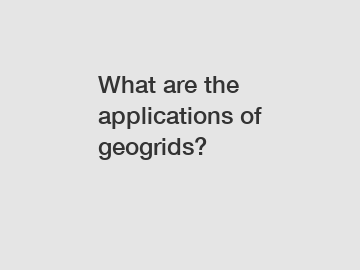What are the applications of geogrids?
Geogrids are innovative materials used in various construction and civil engineering projects. These strong and flexible grids are composed of polymer materials and have numerous applications across different industries. Their primary purpose is to provide reinforcement and stabilization to soil, creating a stronger foundation for construction projects. With their impressive strength, durability, and versatility, geogrids offer several benefits and have become a valuable tool in various engineering projects.
Soil Stabilization:
One of the primary applications of geogrids is in soil stabilization. Geogrids are often used to reinforce soil that may be prone to erosion or unstable due to heavy loads or poor ground conditions. By adding geogrids to the soil, they enhance load distribution, reduce stress, and improve overall stability. This is particularly useful in road construction, where geogrids can help prevent the formation of cracks and potholes.

Retaining Walls:
Geogrids are also commonly used in the construction of retaining walls. These walls are designed to hold back soil or other materials, preventing erosion and maintaining the integrity of the structure. By installing geogrids within the layers of the wall, the soil behind it becomes more stable, reducing the risk of structural failure. Geogrids in retaining walls distribute the load uniformly, mitigating the pressure on the wall and increasing its overall stability.
Slope Reinforcement:
Slopes can be inherently unstable and prone to erosion. Geogrids are capable of reinforcing slopes, preventing soil movement and erosion. By installing geogrids horizontally within the slope, they act as a barrier, reducing pressure and minimizing the risk of soil movement. Geogrids also improve drainage, allowing excess water to flow through the grid, further stabilizing the slope.
Pavements and Roadways:
Geogrids are extensively used in the construction of pavements and roadways to improve their strength and durability. By integrating geogrids between different pavement layers, such as subbase and base layers, they add stability to the structure. This not only effectively distributes the load but also minimizes the potential for cracks and deformation caused by heavy traffic and environmental conditions.
Railway Platforms:
Railway platforms require a solid and stable foundation to ensure the safety and efficiency of train operations. Geogrids provide excellent reinforcement for railway platforms, preventing soil displacement caused by vibrations from trains and reducing settlement. Additionally, geogrids help distribute loads uniformly, minimizing the risk of differential settlement and maintaining a level surface.
Erosion Control:
Geogrids are also widely used for erosion control in various applications. They are employed along shorelines, riverbanks, and slopes to prevent erosion caused by water currents and rainfall. Geogrids help to stabilize the soil and protect it from erosion, preserving the integrity of the land and preventing sedimentation in water bodies.
In conclusion, geogrids have a wide range of applications in the construction and civil engineering industries. Whether it's soil stabilization, retaining walls, slope reinforcement, pavement construction, railway platforms, or erosion control, these versatile grids offer excellent reinforcement and stability. Geogrids have become an essential tool for engineers, providing cost-effective solutions for projects that require enhanced load distribution, improved stability, and extended structure longevity.
For more information about the applications of geogrids and how they can benefit your project, please do not hesitate to contact us.
For more concrete protective lining custom, tailings storage facilities geomembrane, application of geomembrane in environmental protectioninformation, please contact us. We will provide professional answers.
150
0
0


Comments
All Comments (0)